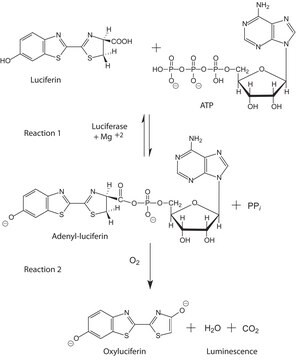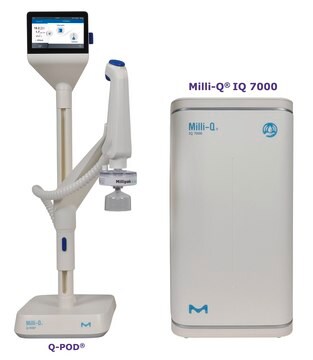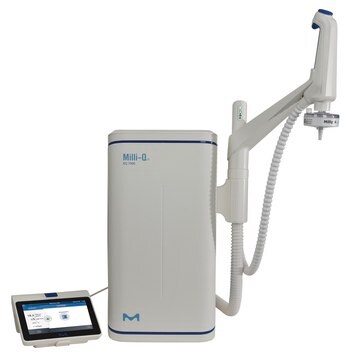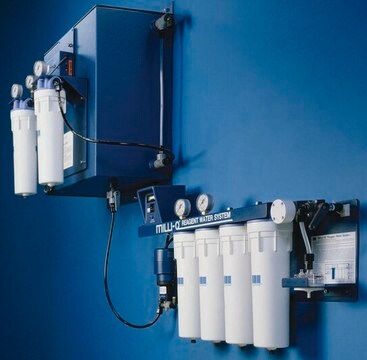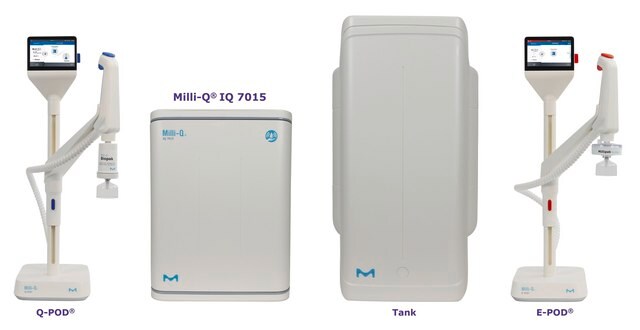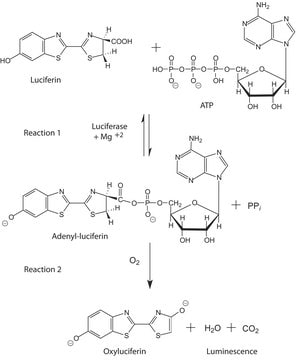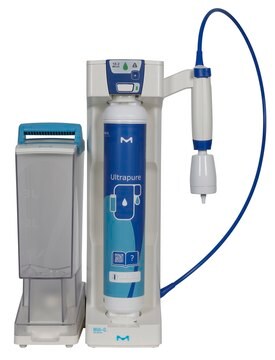11699695001
Roche
ATP Bioluminescence Assay Kit CLS II
sufficient for 800 assays (tubes), kit of 1 (2 components), suitable for detection
Sinônimo(s):
bioluminescence assay
Faça loginpara ver os preços organizacionais e de contrato
About This Item
Código UNSPSC:
12352204
Produtos recomendados
Ensaio
>98%
Nível de qualidade
uso
sufficient for 800 assays (tubes)
embalagem
kit of 1 (2 components)
fabricante/nome comercial
Roche
Parâmetros
15-25 °C optimum reaction temp.
aplicação(ões)
detection
Condições de expedição
dry ice
temperatura de armazenamento
−20°C
Descrição geral
ATP bioluminescence assay is a sophisticated micro count method. It works based on the capability of fireflies to generate its glowing cold light. Rise in proliferation for all cytohexdrin concentrations can be determined by ATP bioluminescence assay.
Especificidade
The ATP Bioluminescence Assay Kit CLS II is specially developed for applications in which constant light signals are required for kinetic studies of enzymes and metabolic studies, or if coupled enzymatic assays are applied. If ATP determinations are performed manually, the CLS Kit provides high reproducibility due to the constant signal generation.
The sensitivity of the kit is reduced by a factor of 10, compared to the ATP Bioluminescence Assay Kit HS II, which is recommended for determinations that are in the high-sensitivity range. The ATP Bioluminescence Assay Kit HS II also contains an efficient cell lysis reagent, and can be used for the detection of ATP in microorganisms or animal cells.
The sensitivity of the kit is reduced by a factor of 10, compared to the ATP Bioluminescence Assay Kit HS II, which is recommended for determinations that are in the high-sensitivity range. The ATP Bioluminescence Assay Kit HS II also contains an efficient cell lysis reagent, and can be used for the detection of ATP in microorganisms or animal cells.
Aplicação
ATP Bioluminescence Assay Kit CLS II has been used in the determination of the ATP synthetic activity of the H+-ATP synthase, ATP bioluminescent assay and intracellular measurement of ATP levels.
The ATP Bioluminescence Assay Kit CLS II is optimized for easy use in tube luminometers and microplate-format luminometers. The kit exhibits a constant light signal that is sustained for several minutes. The kit is well suited for kinetic studies and ATP determinations in coupled enzymatic reactions.
For more highly sensitive ATP determinations, use the ATP Bioluminescence Assay Kit HS II.
For more highly sensitive ATP determinations, use the ATP Bioluminescence Assay Kit HS II.
Embalagem
1 kit containing 2 components.
Nota de preparo
Working concentration: Working range: 10-6 to 10-11 M ATP
Working solution: Preparation of working solutions
Luciferase Reagent
Dissolve the whole content of one bottle by carefully adding 10 ml of double-dist. water. Incubate for five minutes at 0 to 4 °C without stirring or shaking. Mix for a homogeneous solution by carefully rotating the bottle. Do not shake. The reagent is stable for one day at 15 to 25 °C or for one week when stored at 0 to 4 °C. However, set up a standard curve each day, because a slightly loss of light activity occurs during this time (approx. 20% after 5 days).
ATP Standard
Each bottle contains approx. 10 mg ATP (> 98% purity; Mr 605.2). The exact amount of ATP is determined individually for each lot as indicated on the label. Dissolve the content of one bottle by addition of the appropriate volume of double-dist. water to get a final concentration of 10 mg/ml or 16.5 mM, respectively (e.g., 960 μl to 9.60 mg ATP).
Working solution: Preparation of working solutions
Luciferase Reagent
Dissolve the whole content of one bottle by carefully adding 10 ml of double-dist. water. Incubate for five minutes at 0 to 4 °C without stirring or shaking. Mix for a homogeneous solution by carefully rotating the bottle. Do not shake. The reagent is stable for one day at 15 to 25 °C or for one week when stored at 0 to 4 °C. However, set up a standard curve each day, because a slightly loss of light activity occurs during this time (approx. 20% after 5 days).
ATP Standard
Each bottle contains approx. 10 mg ATP (> 98% purity; Mr 605.2). The exact amount of ATP is determined individually for each lot as indicated on the label. Dissolve the content of one bottle by addition of the appropriate volume of double-dist. water to get a final concentration of 10 mg/ml or 16.5 mM, respectively (e.g., 960 μl to 9.60 mg ATP).
Reconstituição
Roche recommends reconstituting Luciferase Reagent in water and not in buffer.
Outras notas
For life science research only. Not for use in diagnostic procedures.
Somente componentes do kit
Nº do produto
Descrição
- Luciferase Reagent, lyophilized (8)
- ATP Standard, lyophilized (for calibration) (4)
Palavra indicadora
Warning
Frases de perigo
Declarações de precaução
Classificações de perigo
STOT RE 2
Código de classe de armazenamento
11 - Combustible Solids
Classe de risco de água (WGK)
WGK 2
Ponto de fulgor (°F)
does not flash
Ponto de fulgor (°C)
does not flash
Certificados de análise (COA)
Busque Certificados de análise (COA) digitando o Número do Lote do produto. Os números de lote e remessa podem ser encontrados no rótulo de um produto após a palavra “Lot” ou “Batch”.
Já possui este produto?
Encontre a documentação dos produtos que você adquiriu recentemente na biblioteca de documentos.
A novel role of the mitochondrial permeability transition pore in (?)-gossypol-induced mitochondrial dysfunction.
Warnsmann V, et al.
Mechanisms of Ageing and Development, 170, 45-58 (2018)
Principles of Bacterial Detection: Biosensors, Recognition Receptors and Microsystems: Biosensors, Recognition Receptors, and Microsystem (2008)
Pamela Becherini et al.
Cancer & metabolism, 9(1), 6-6 (2021-01-24)
Sirtuin 6 (SIRT6) is a NAD+-dependent deacetylase with key roles in cell metabolism. High SIRT6 expression is associated with adverse prognosis in breast cancer (BC) patients. However, the mechanisms through which SIRT6 exerts its pro-oncogenic effects in BC remain unclear.
Víctor Mayoral-Varo et al.
PloS one, 15(7), e0235850-e0235850 (2020-07-17)
Deregulation of Src kinases is associated with cancer. We previously showed that SrcDN conditional expression in MCF7 cells reduces tumorigenesis and causes tumor regression in mice. However, it remained unclear whether SrcDN affected breast cancer stem cell functionality or it
Intracellular assessment of ATP levels in Caenorhabditis elegans.
Palikaras K and Tavernarakis N
Bio-protocol, 6(23), e22048-e22048 (2016)
Nossa equipe de cientistas tem experiência em todas as áreas de pesquisa, incluindo Life Sciences, ciência de materiais, síntese química, cromatografia, química analítica e muitas outras.
Entre em contato com a assistência técnica